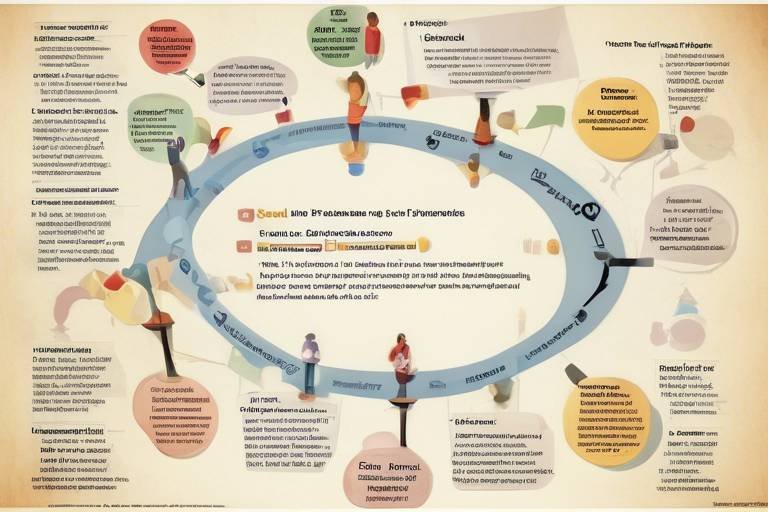The Science of Open Peer Review in Academic Publishing
In the ever-evolving landscape of academic publishing, the concept of open peer review has emerged as a transformative force, reshaping how research is evaluated and disseminated. Unlike traditional peer review, where the identities of reviewers are often hidden, open peer review embraces transparency, allowing both the authors and the community to see who is providing feedback. This shift not only encourages a more collaborative environment but also enhances the integrity and credibility of published research. Imagine a world where every critique is visible and accountable, much like a public debate where every speaker is known. This article aims to delve into the nuances of open peer review, exploring its benefits, challenges, and the profound impact it has on the quality of academic work.
The significance of open peer review cannot be overstated. In a time when misinformation can spread like wildfire, having a transparent review process acts as a safeguard against bias and unverified claims. It invites scrutiny and discussion, creating an ecosystem where knowledge can flourish. By understanding the mechanisms of open peer review, we can appreciate how it promotes not just accountability but also a culture of trust among researchers and the broader academic community. As we navigate through this article, we will uncover how open peer review serves as a beacon of hope for enhancing research integrity in a world that increasingly demands transparency.
As we explore the benefits and challenges of open peer review, it becomes clear that this model is not just a trend but a necessary evolution in academic publishing. The dialogue surrounding open peer review is rich and multifaceted, presenting a unique opportunity for researchers to engage in meaningful exchanges that can lead to groundbreaking discoveries. So, buckle up as we embark on this enlightening journey through the science of open peer review, where every voice matters, and every critique counts!

Understanding Open Peer Review
Open peer review represents a revolutionary shift in the landscape of academic publishing, challenging traditional norms and enhancing the integrity of research. But what exactly is open peer review? In simple terms, it is a transparent process where the identities of the reviewers are known to the authors and the public. This model contrasts with the conventional blind review process, where reviewers remain anonymous. By shedding light on the review process, open peer review aims to foster a culture of accountability and openness, which is essential in today's fast-paced research environment.
The significance of open peer review extends beyond mere transparency; it serves as a catalyst for improved quality and credibility in scholarly work. Researchers and readers alike can engage with the review process, enabling them to understand the rationale behind the feedback provided. This level of engagement not only demystifies the review process but also encourages a more collaborative approach to research. Imagine stepping into a vibrant marketplace of ideas where every voice matters, and every critique is a stepping stone towards excellence. That’s the essence of open peer review!
Moreover, the open peer review process can significantly enhance the dialogue between authors and reviewers. When reviewers know their identities are public, they tend to provide more constructive and thoughtful feedback. This interaction can lead to more rigorous evaluations, as reviewers feel a sense of responsibility towards the authors and the broader academic community. In this way, open peer review not only democratizes the evaluation process but also enriches the quality of the research being published.
In addition to its benefits, open peer review also highlights the importance of ethical considerations in research. By promoting transparency, it encourages researchers to uphold high standards of integrity in their work. This is crucial in an era where research misconduct can have far-reaching consequences, not just for individual careers but for the scientific community as a whole. Therefore, open peer review is not merely a procedural change; it's a fundamental shift towards a more ethical and responsible approach to academic publishing.
In conclusion, understanding open peer review is essential for anyone involved in academic research. It embodies a commitment to transparency, accountability, and ethical standards, ultimately enhancing the quality and credibility of scholarly work. As we continue to navigate the complexities of research and publishing, embracing open peer review could be one of the most significant steps we take towards fostering a more robust and trustworthy academic environment.

Benefits of Open Peer Review
Open peer review is not just a buzzword; it’s a transformative approach in the realm of academic publishing that brings a plethora of benefits to the table. One of the most significant advantages is the increase in transparency. In traditional peer review, the identities of reviewers are often kept secret, which can lead to a lack of accountability and potential biases. However, in an open peer review system, the identities of the reviewers are disclosed, allowing for greater scrutiny of their evaluations. This transparency fosters trust among researchers, readers, and institutions alike, as everyone can see who reviewed the work and how they arrived at their conclusions.
Moreover, open peer review enhances collaboration within the academic community. When reviewers' identities are known, it opens the door for constructive discussions and knowledge sharing among researchers. Imagine a scenario where a researcher receives feedback from a reviewer who is also a leading expert in their field. This could lead to a collaborative effort, where both parties can exchange ideas, resulting in innovative solutions and advancements in research. It’s akin to a brainstorming session where everyone’s input is valued and can lead to breakthroughs that might not have happened in a closed environment.
Another crucial benefit is the potential for improved quality of research. With open peer review, the expectation for thorough evaluations rises. Reviewers are more likely to provide constructive feedback when they know their names are attached to their reviews. This accountability can lead to more rigorous critiques, ultimately enhancing the quality of the research being published. Think of it as a team of chefs working together to perfect a recipe; each chef brings their expertise, and the end result is a dish that is far superior to what any one chef could create alone.
Furthermore, open peer review can help in mitigating biases that often plague traditional peer review processes. Biases can stem from various sources, including the reviewers' personal opinions or institutional affiliations. By making the review process transparent, it becomes easier to identify and challenge these biases. This leads to fairer evaluations, ensuring that research is assessed based on its merit rather than the reputation of the authors or the institutions they represent. In a way, it’s like shining a light in a dark room; biases that were once hidden can now be exposed and addressed.
To summarize the benefits of open peer review, consider the following key points:
- Transparency: Builds trust and accountability.
- Collaboration: Encourages knowledge sharing and innovative solutions.
- Improved Quality: Leads to more rigorous and constructive feedback.
- Bias Mitigation: Helps identify and reduce biases in the review process.
In conclusion, the shift towards open peer review is not just a trend; it’s a necessary evolution in the academic publishing landscape. By embracing this model, we can enhance the integrity of research, foster collaboration, and ultimately contribute to a more robust and credible body of knowledge.
1. What is open peer review?
Open peer review is a transparent process in which the identities of reviewers are known, allowing for greater accountability and openness in the evaluation of academic work.
2. How does open peer review improve research quality?
By ensuring that reviewers are accountable for their feedback, open peer review leads to more constructive critiques and thorough evaluations, ultimately enhancing the quality of published research.
3. What challenges does open peer review face?
Despite its benefits, open peer review can encounter challenges such as potential biases, the risk of harassment, and the need for a cultural shift within the academic community.
4. How can biases be addressed in open peer review?
Transparency in the review process helps identify biases that may exist, allowing for fairer evaluations based on the merit of the research rather than the reputation of the authors.

Transparency in the Review Process
Transparency in the review process is like opening the curtains in a dimly lit room; it allows everyone to see the inner workings of academic publishing. In traditional peer review, the identities of reviewers are often kept secret, which can lead to questions about the fairness and objectivity of their evaluations. However, with open peer review, the veil is lifted, and both the reviewers' identities and their comments are made visible to the public. This shift not only promotes accountability but also fosters a culture of trust among researchers, authors, and readers alike.
By allowing the community to scrutinize the review process, open peer review addresses several critical issues:
- Mitigation of Bias: When reviewers know their identities will be revealed, they are less likely to let personal biases influence their evaluations. This transparency helps ensure that the review process is more objective and fair.
- Encouragement of Constructive Feedback: Knowing that their critiques will be public can motivate reviewers to provide more thoughtful and constructive feedback, ultimately enhancing the quality of the research.
- Building Trust: Transparency fosters trust not only in the review process but also in the published research itself. When readers can see the reviewers' comments and the authors' responses, they are more likely to trust the integrity of the findings.
Moreover, transparency in the review process can lead to a more engaged academic community. When researchers can openly discuss and critique one another's work, it creates an environment ripe for collaboration and innovation. This open dialogue can spark new ideas, challenge existing paradigms, and ultimately drive advancements in various fields of study.
However, it's essential to recognize that transparency is not without its challenges. Some may fear that revealing their identities could lead to potential backlash or harassment, particularly in contentious fields. Therefore, implementing open peer review requires careful consideration of the potential risks involved. Institutions and journals must develop robust policies to protect reviewers while still promoting an open and transparent environment.
In conclusion, the transparency of the review process in open peer review serves as a catalyst for change in academic publishing. By embracing this model, we can enhance the integrity of research, build trust within the academic community, and encourage a culture of constructive feedback and collaboration. As we continue to explore this evolving landscape, it's crucial to address the challenges that come with transparency to ensure that it benefits all stakeholders involved.

Accountability of Reviewers
In the realm of academic publishing, the plays a pivotal role in maintaining the integrity and quality of research. When reviewers know their identities are disclosed, it creates a sense of responsibility that is often absent in traditional peer review processes. This shift not only encourages reviewers to provide more constructive feedback but also fosters a culture of respect and professionalism within the academic community. Imagine a world where every critique is made with the understanding that it could be scrutinized by peers; it’s a game-changer!
The implications of this accountability are profound. For one, it can lead to a more thorough evaluation of submitted manuscripts. Reviewers are less likely to dismiss important aspects of a study when they know their opinions are tied to their names. Furthermore, this transparency can help to mitigate biases that often plague the review process. For instance, if a reviewer has a personal or professional bias against an author, the knowledge that their feedback will be publicly attributed can deter them from unfairly criticizing the work.
Moreover, accountability can enhance the overall quality of the review process. Reviewers are more inclined to engage deeply with the material, knowing that their evaluations will be subject to public scrutiny. This can lead to richer, more insightful critiques that not only benefit the authors but also advance the field as a whole. In this way, accountability acts as a catalyst for improvement, pushing reviewers to strive for excellence.
However, it is essential to recognize that with this accountability comes the potential for harassment or negative feedback directed at reviewers, especially if their evaluations are controversial. To combat this, journals must implement robust support systems that protect reviewers from undue criticism while still promoting open discourse. The balance between accountability and safety is delicate but crucial for the success of open peer review.
In conclusion, the accountability of reviewers in an open peer review system not only enhances the quality of the feedback provided but also strengthens the trust in the academic publishing process. By ensuring that reviewers are responsible for their evaluations, we pave the way for a more transparent, fair, and constructive academic environment.
- What is open peer review?
Open peer review is a transparent review process where the identities of reviewers are known, promoting accountability and openness in academic publishing.
- How does accountability improve the review process?
Accountability encourages reviewers to provide more constructive feedback and reduces biases, leading to a more thorough evaluation of research.
- What challenges does open peer review face?
Open peer review can face challenges such as potential biases, harassment, and the need for robust support systems for reviewers.

Enhancing Collaboration
In the world of academia, collaboration is not just a buzzword; it's a necessity. Open peer review acts as a catalyst for collaboration among researchers, breaking down the silos that often exist in traditional academic publishing. Imagine a vibrant marketplace of ideas where researchers can share insights, critique each other's work, and brainstorm innovative solutions. This is precisely what open peer review facilitates.
One of the most significant advantages of open peer review is that it encourages open discussions among scholars. When reviewers' identities are disclosed, it creates a sense of community and trust. Researchers feel more comfortable engaging in constructive dialogues, sharing their thoughts, and even challenging each other's findings. This dynamic interaction not only enriches the research process but also leads to a more holistic understanding of the subject matter.
Furthermore, open peer review promotes knowledge sharing. When researchers know who their reviewers are, they can reach out to them for further discussions, clarifications, or even collaborative projects. This networking opportunity can lead to groundbreaking research partnerships that might not have been possible in a more opaque review process. For instance, a researcher working on a new methodology might connect with a reviewer who has extensive experience in that area, leading to a fruitful collaboration that enhances both parties' work.
Additionally, open peer review can help in identifying interdisciplinary connections. In today's complex research landscape, many problems require insights from various fields. By making the review process transparent, researchers from different disciplines can come together, share their unique perspectives, and contribute to a more comprehensive understanding of the research topic. This cross-pollination of ideas can lead to innovative solutions that are both practical and impactful.
To further illustrate the impact of open peer review on collaboration, consider the following table that summarizes key aspects:
| Aspect | Traditional Peer Review | Open Peer Review |
|---|---|---|
| Transparency | Limited | High |
| Reviewer Anonymity | Anonymous | Identified |
| Collaboration Opportunities | Rare | Frequent |
| Knowledge Sharing | Minimal | Extensive |
In conclusion, open peer review is more than just a method of evaluation; it's a transformative approach that enhances collaboration among researchers. By fostering an environment of trust, encouraging open discussions, and facilitating knowledge sharing, it paves the way for innovative research that can address the complex challenges of our time. As we continue to embrace this model, the potential for groundbreaking collaborations will only grow, ultimately enriching the academic landscape.

Challenges of Open Peer Review
While the concept of open peer review appears to be a beacon of hope for enhancing transparency and accountability in academic publishing, it is not without its challenges. One of the primary concerns is the potential for bias in the review process. Even though open peer review aims to reduce biases by making the identities of reviewers known, it can inadvertently lead to situations where reviewers may feel pressured to conform to prevailing opinions or the expectations of their peers. This pressure can skew their evaluations and compromise the integrity of the review process.
Another significant challenge is the risk of harassment. When identities are disclosed, there is a possibility that reviewers may face backlash from authors or their supporters, particularly if the feedback is critical. This environment can create a chilling effect, discouraging honest and constructive critiques. The fear of negative repercussions can lead to superficial reviews, which ultimately undermines the goal of improving research quality.
Additionally, the implementation of open peer review can lead to logistical hurdles. For instance, not all journals are equipped to handle the open review process efficiently. This can create inconsistencies in how reviews are conducted and reported. Some journals may struggle with maintaining the confidentiality of sensitive information while trying to promote transparency, leading to a disconnect in the review process.
Moreover, the cultural acceptance of open peer review varies significantly across different fields of study. In some disciplines, traditional peer review remains the norm, and there may be resistance to adopting a more open approach. This resistance can stem from a lack of understanding of the benefits of open peer review or a belief that it could compromise the quality of reviews.
Lastly, the quality of feedback can also be a concern. While the intention of open peer review is to foster constructive criticism, the reality is that not all reviewers possess the skills or willingness to provide valuable insights. There can be instances where the feedback is either too harsh or too lenient, failing to serve its purpose of improving the research. This inconsistency can lead to frustration among authors and readers alike.
In summary, while open peer review holds great promise for enhancing the integrity of academic publishing, it faces several challenges that must be addressed. These challenges include biases, the risk of harassment, logistical issues, cultural resistance, and variability in the quality of feedback. Addressing these obstacles will be crucial for the successful implementation and acceptance of open peer review in the academic community.
- What is open peer review? Open peer review is a transparent process in which the identities of reviewers are disclosed, promoting accountability and openness in academic publishing.
- What are the main benefits of open peer review? The main benefits include increased transparency, enhanced collaboration, and improved quality of research.
- What challenges does open peer review face? Challenges include potential biases, the risk of harassment, logistical hurdles, cultural resistance, and variability in the quality of feedback.
- How does open peer review impact research quality? Open peer review can enhance the rigor of research by ensuring thorough evaluations and constructive critiques.

Impact on Research Quality
The shift towards open peer review has significant implications for the quality of research published. In an era where academic integrity and the reliability of scholarly contributions are paramount, this innovative model of peer evaluation stands out as a beacon of hope. Open peer review not only enhances the transparency of the review process but also actively influences the rigor with which research is scrutinized. Imagine a world where every piece of research is subjected to a thorough and transparent evaluation; that’s the promise of open peer review.
One of the most compelling aspects of open peer review is its ability to improve the rigor of research. Traditional peer review processes often operate behind closed doors, leaving room for subjective judgments and biases to creep in. However, with open peer review, the curtain is lifted, allowing for a more comprehensive evaluation. Reviewers are more likely to provide detailed critiques when their identities are known, leading to constructive feedback that can significantly enhance the quality of the work. This shift encourages authors to engage more deeply with the feedback they receive, fostering a culture of improvement and academic excellence.
Moreover, the transparency inherent in open peer review acts as a safeguard against biases that can plague traditional peer review processes. In many cases, reviewers may unconsciously favor certain methodologies, institutions, or even authors based on prior relationships or reputations. Open peer review seeks to address these issues head-on. By making the review process public, it becomes easier to identify and mitigate biases, leading to fairer evaluations. This transparency not only benefits the authors but also enhances the credibility of the research itself, as readers can trust that the findings have been rigorously vetted.
To illustrate the impact of open peer review on research quality, consider the following table that compares traditional peer review with open peer review:
| Aspect | Traditional Peer Review | Open Peer Review |
|---|---|---|
| Transparency | Limited | High |
| Reviewer Accountability | Low | High |
| Potential for Bias | Higher | Lower |
| Quality of Feedback | Variable | Consistently Constructive |
As we can see, the advantages of open peer review extend beyond mere transparency; they encompass a holistic improvement in the quality and reliability of research outputs. Furthermore, the collaborative nature of open peer review encourages a community-driven approach to research evaluation. Researchers from diverse backgrounds can contribute their insights, leading to a more rounded and enriched critique of the work being reviewed. This collaborative spirit not only enhances the quality of individual studies but also contributes to the advancement of knowledge across disciplines.
In conclusion, the impact of open peer review on research quality is profound and multifaceted. By fostering transparency, accountability, and collaboration, this model not only improves the rigor of research but also helps to build a more trustworthy academic landscape. As we continue to navigate the complexities of academic publishing, embracing open peer review could very well be the key to unlocking a new era of research integrity and excellence.
- What is open peer review? Open peer review is a process where the identities of reviewers are known, promoting transparency and accountability in the evaluation of academic work.
- How does open peer review enhance research quality? It improves research quality by providing constructive feedback, reducing biases, and encouraging collaboration among researchers.
- What challenges does open peer review face? Some challenges include potential biases, the risk of harassment, and resistance from traditionalists in the academic community.
- Is open peer review widely adopted? While gaining traction, open peer review is not yet universally adopted, but its popularity is increasing in various fields.

Improving Rigor in Research
When we talk about , it's essential to understand that this isn't just about adhering to strict guidelines; it’s about fostering a culture of excellence and integrity in academic work. Open peer review plays a pivotal role in this transformation. By allowing reviewers to see each other's comments and evaluations, we create an environment where feedback is not only welcomed but also scrutinized. Imagine a workshop where every craftsman can see what others are creating and how they are doing it. This shared visibility leads to a collective elevation of standards.
One of the most significant advantages of open peer review is the opportunity for thorough evaluations. Unlike traditional peer review, where feedback can sometimes be vague or overly lenient, the open model encourages reviewers to provide detailed critiques. This not only helps authors refine their work but also ensures that the research meets the highest standards before it is published. Think of it as a rigorous training program where every participant pushes each other to improve. The result? A body of research that is not only reliable but also groundbreaking.
Moreover, the open nature of this process can lead to a more constructive dialogue between authors and reviewers. When identities are known, there’s a greater chance for meaningful discussions, which can illuminate areas of research that may have been overlooked. For instance, if a reviewer points out a potential flaw in the methodology, the author can respond and clarify their approach, leading to a richer understanding of the research question. This back-and-forth communication can significantly enhance the overall quality of the work.
To illustrate the impact of open peer review on research rigor, consider the following table that summarizes key aspects:
| Aspect | Traditional Peer Review | Open Peer Review |
|---|---|---|
| Transparency | Limited visibility | Full visibility of reviews |
| Feedback Quality | Variable, sometimes vague | Detailed and constructive |
| Reviewer Accountability | Anonymous | Identities known |
| Collaboration | Minimal interaction | Encourages discussion |
In conclusion, the shift towards open peer review is not just a trend; it’s a fundamental change in how we approach academic publishing. By improving the rigor of research through transparency, accountability, and constructive feedback, we can ensure that the work we publish is not only credible but also contributes meaningfully to the body of knowledge in various fields. This collaborative approach is akin to a scientific symphony, where each contributor plays a vital role in creating a masterpiece of research.
- What is open peer review? Open peer review is a transparent evaluation process where the identities of reviewers are known, promoting accountability and openness.
- How does open peer review improve research quality? It enhances research quality by fostering thorough evaluations, constructive feedback, and collaboration among researchers.
- What are the challenges of open peer review? Potential biases and risks of harassment are some challenges that need to be addressed for effective implementation.
- Can open peer review reduce biases? Yes, the transparency of the process can help identify and mitigate biases that occur in traditional peer review.

Addressing Biases in Peer Review
In the realm of academic publishing, biases can often sneak into the peer review process like uninvited guests at a party. These biases can stem from various sources, including the reviewer's personal beliefs, institutional affiliations, or even the gender and nationality of the authors. The traditional peer review process, shrouded in anonymity, can sometimes exacerbate these issues, as reviewers may feel less accountable for their evaluations. However, open peer review presents a refreshing approach to tackling these biases head-on.
By making the identities of reviewers known, open peer review fosters a culture of transparency and responsibility. When reviewers know their names will be attached to their critiques, they are more likely to provide fair and constructive feedback. This accountability can significantly reduce the likelihood of biases influencing their evaluations. For instance, a study published in the journal "Nature" found that open peer review led to more balanced assessments, particularly in cases where authors were from underrepresented backgrounds.
Moreover, the transparent nature of open peer review allows for greater scrutiny of the review process itself. When the community can see who is reviewing what, it becomes easier to identify patterns of bias. If a particular reviewer consistently rates submissions from specific institutions or demographics unfairly, this can be flagged and addressed. This level of oversight not only enhances the credibility of the review process but also encourages reviewers to be more mindful of their potential biases.
Another significant advantage of open peer review is the opportunity for collaboration and discourse among researchers. When reviewers engage openly, they can discuss their thoughts and provide insights that go beyond mere evaluations. This collaborative environment can help unearth hidden biases, as researchers from diverse backgrounds can weigh in on the review process, offering perspectives that might not have been considered otherwise. As a result, the reviews become richer and more comprehensive, ultimately benefiting the quality of published research.
To illustrate the impact of open peer review on addressing biases, consider the following table:
| Aspect | Traditional Peer Review | Open Peer Review |
|---|---|---|
| Reviewer Anonymity | Anonymous | Identified |
| Accountability | Low | High |
| Transparency | Limited | Enhanced |
| Potential for Bias | Higher | Lower |
In conclusion, addressing biases in peer review is crucial for maintaining the integrity of academic research. Open peer review not only promotes accountability and transparency but also encourages collaboration among researchers. By embracing this model, the academic community can work together to ensure that evaluations are fair and equitable, ultimately leading to a more robust body of scholarly work. So, the next time you think about the peer review process, remember that opening the doors can lead to brighter insights and a more inclusive environment for all researchers.
- What is open peer review? Open peer review is a transparent process where the identities of reviewers are known, promoting accountability and openness.
- How does open peer review reduce bias? By making reviewers accountable for their evaluations, it encourages fair and constructive feedback.
- What are the benefits of transparency in peer review? Transparency fosters trust among researchers and readers, leading to improved credibility of published research.
- Can open peer review enhance collaboration? Yes, it facilitates open discussions and knowledge sharing, leading to innovative solutions.
Frequently Asked Questions
- What is open peer review?
Open peer review is a transparent process in academic publishing where the identities of the reviewers are known to both the authors and the readers. This approach promotes accountability and encourages open dialogue about the research being evaluated.
- What are the main benefits of open peer review?
Open peer review offers several advantages, including increased transparency, enhanced collaboration among researchers, and improved quality of published research. By making the review process visible, it helps build trust and credibility in academic work.
- How does transparency in open peer review improve research integrity?
Transparency allows for greater scrutiny of the review process, which can mitigate biases and enhance the credibility of published research. When everyone knows who the reviewers are, it encourages them to provide more constructive and thoughtful feedback.
- Are reviewers held accountable in open peer review?
Yes, in open peer review, reviewers are held accountable for their evaluations. This accountability can lead to more rigorous and constructive feedback, ultimately improving the quality of the review process and the research itself.
- What challenges does open peer review face?
Despite its benefits, open peer review encounters challenges such as potential biases, the risk of harassment, and resistance from traditionalists in the academic community. Addressing these issues is crucial for the successful implementation of this model.
- How does open peer review impact the quality of research?
The shift towards open peer review has significant implications for research quality. By ensuring thorough evaluations and constructive critiques, it enhances the rigor and reliability of academic contributions, leading to more trustworthy publications.
- Can open peer review reduce biases in the review process?
Yes, open peer review aims to reduce biases that can occur in traditional review processes. By making the review process transparent, it helps identify and mitigate these biases, leading to fairer evaluations of research work.

















